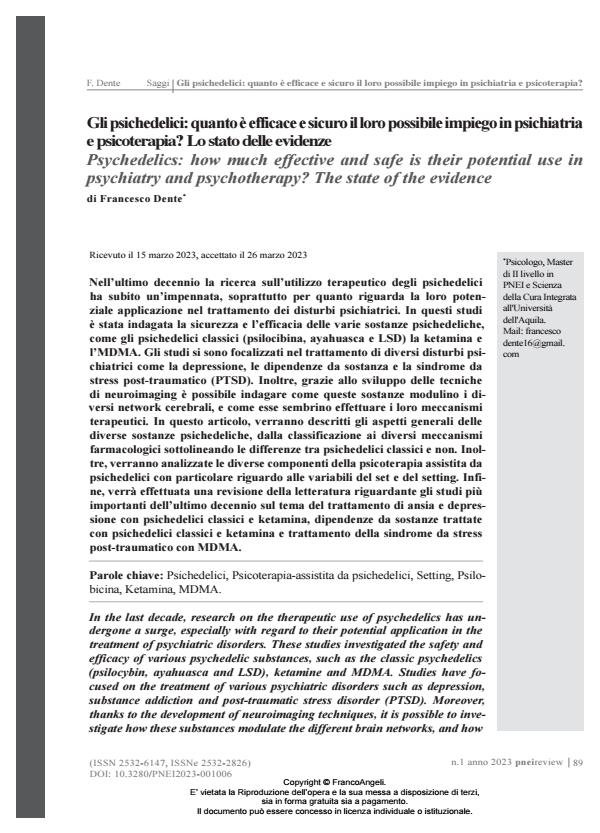Gli psichedelici: quanto è efficace e sicuro il loro possibile impiego in psichiatriae psicoterapia? Lo stato delle evidenze
Titolo Rivista PNEI REVIEW
Autori/Curatori Francesco Dente
Anno di pubblicazione 2023 Fascicolo 2023/1
Lingua Italiano Numero pagine 17 P. 89-105 Dimensione file 1110 KB
DOI 10.3280/PNEI2023-001006
Il DOI è il codice a barre della proprietà intellettuale: per saperne di più
clicca qui
Qui sotto puoi vedere in anteprima la prima pagina di questo articolo.
Se questo articolo ti interessa, lo puoi acquistare (e scaricare in formato pdf) seguendo le facili indicazioni per acquistare il download credit. Acquista Download Credits per scaricare questo Articolo in formato PDF

FrancoAngeli è membro della Publishers International Linking Association, Inc (PILA)associazione indipendente e non profit per facilitare (attraverso i servizi tecnologici implementati da CrossRef.org) l’accesso degli studiosi ai contenuti digitali nelle pubblicazioni professionali e scientifiche
Nell’ultimo decennio la ricerca sull’utilizzo terapeutico degli psichedelici ha subito un’impennata, soprattutto per quanto riguarda la loro poten- ziale applicazione nel trattamento dei disturbi psichiatrici. In questi studi è stata indagata la sicurezza e l’efficacia delle varie sostanze psichedeliche, come gli psichedelici classici (psilocibina, ayahuasca e LSD) la ketamina e l’MDMA. Gli studi si sono focalizzati nel trattamento di diversi disturbi psi- chiatrici come la depressione, le dipendenze da sostanza e la sindrome da stress post-traumatico (PTSD). Inoltre, grazie allo sviluppo delle tecniche di neuroimaging è possibile indagare come queste sostanze modulino i di- versi network cerebrali, e come esse sembrino effettuare i loro meccanismi terapeutici. In questo articolo, verranno descritti gli aspetti generali delle diverse sostanze psichedeliche, dalla classificazione ai diversi meccanismi farmacologici sottolineando le differenze tra psichedelici classici e non. Inol- tre, verranno analizzate le diverse componenti della psicoterapia assistita da psichedelici con particolare riguardo alle variabili del set e del setting. Infi- ne, verrà effettuata una revisione della letteratura riguardante gli studi più importanti dell’ultimo decennio sul tema del trattamento di ansia e depres- sione con psichedelici classici e ketamina, dipendenze da sostanze trattate con psichedelici classici e ketamina e trattamento della sindrome da stress post-traumatico con MDMA.
Parole chiave:Psichedelici, Psicoterapia-assistita da psichedelici, Setting, Psilo- bicina, Ketamina, MDMA.
Francesco Dente, Gli psichedelici: quanto è efficace e sicuro il loro possibile impiego in psichiatriae psicoterapia? Lo stato delle evidenze in "PNEI REVIEW" 1/2023, pp 89-105, DOI: 10.3280/PNEI2023-001006